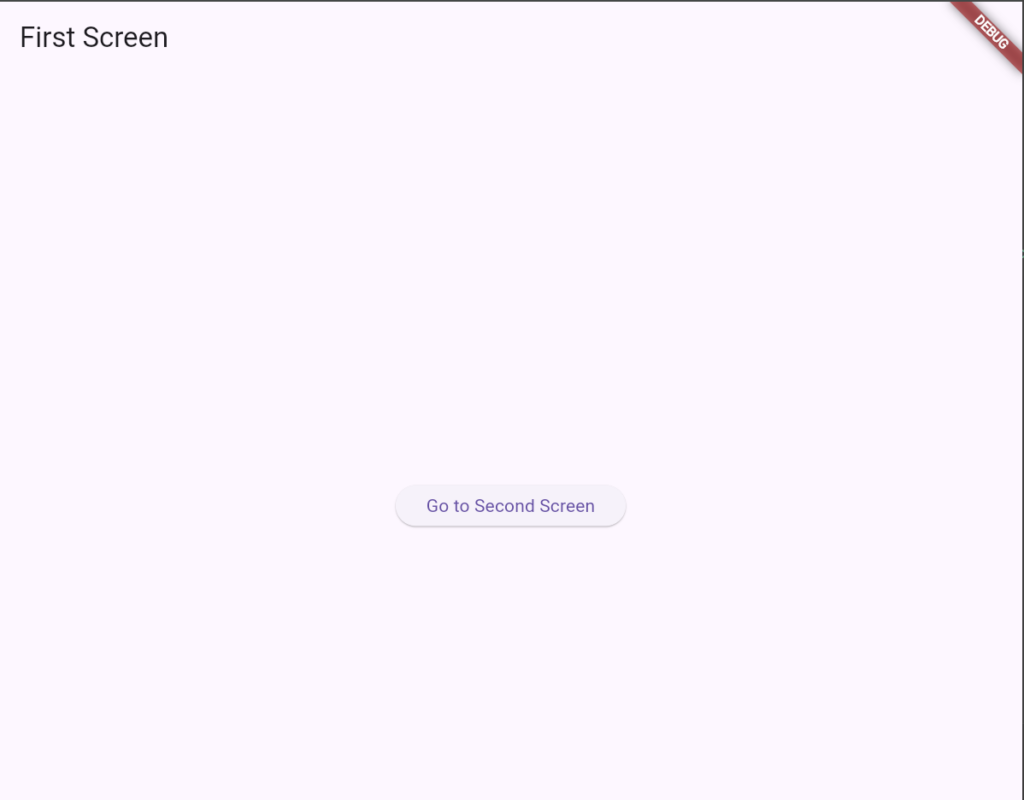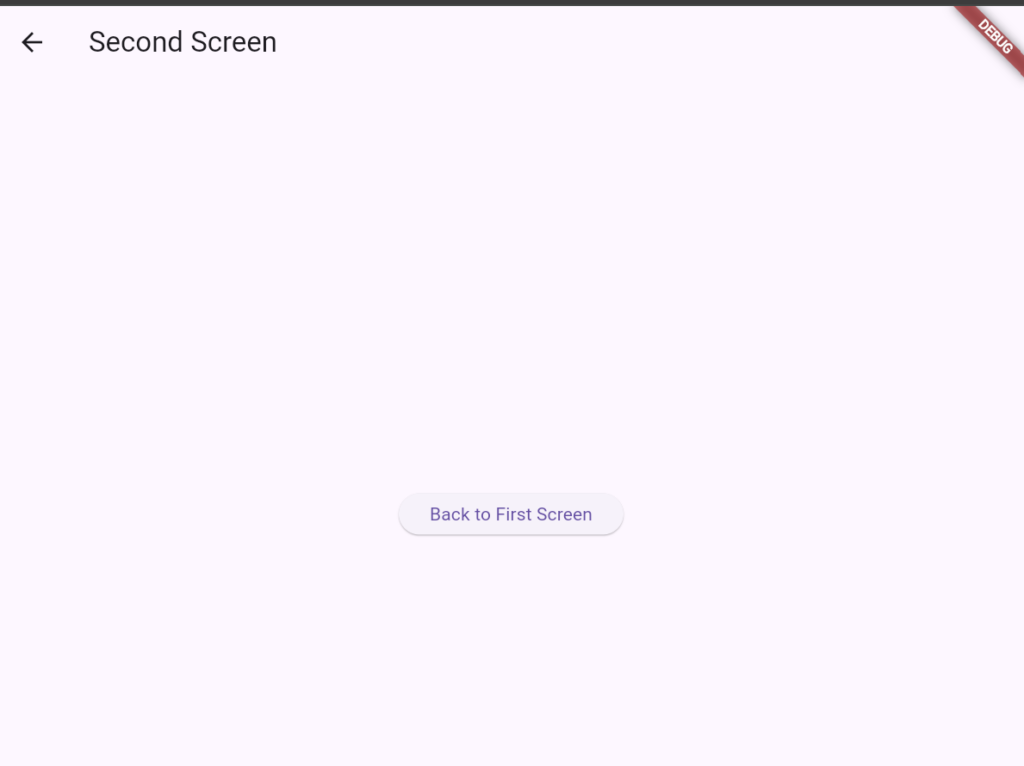Basic file setup
Create a new Flutter project or open an existing one. We will add examples of each button in the main.dart file.
import 'package:flutter/material.dart';
void main() {
runApp(const MainApp());
}
class MainApp extends StatelessWidget {
const MainApp({super.key});
@override
Widget build(BuildContext context) {
return MaterialApp(
home: Scaffold(
body: Center(
child: //add code here
)
),
);
}
}Navigator
The Navigator widget is used to manage a stack of routes (screens).


FirstScreen.dart file
import 'package:flutter/material.dart';
import 'package:basic_widgets/SecondScreen.dart';
class FirstScreen extends StatelessWidget {
@override
Widget build(BuildContext context) {
return Scaffold(
appBar: AppBar(title: Text("First Screen")),
body: Center(
child: ElevatedButton(
onPressed: () {
Navigator.push(
context,
MaterialPageRoute(builder: (context) => SecondScreen()),
);
},
child: Text("Go to Second Screen"),
),
),
);
}
}SecondScreen.dart file
import 'package:flutter/material.dart';
class SecondScreen extends StatelessWidget {
@override
Widget build(BuildContext context) {
return Scaffold(
appBar: AppBar(title: Text("Second Screen")),
body: Center(
child: ElevatedButton(
onPressed: () {
Navigator.pop(context);
},
child: Text("Back to First Screen"),
),
),
);
}
}main.dart file
import 'package:basic_widgets/FirstScreen.dart';
import 'package:flutter/material.dart';
void main() {
runApp(const MainApp());
}
class MainApp extends StatelessWidget {
const MainApp({super.key});
@override
Widget build(BuildContext context) {
return MaterialApp(
home: Scaffold(
body: Center(
child: FirstScreen()//add code here
)
),
);
}
}Key Points:
- Use
Navigator.pushto navigate to a new screen. - Use
Navigator.popto return to the previous screen.
PageView
The PageView widget allows horizontal swiping between pages.
PageViewExample.dart file
import 'package:flutter/material.dart';
import 'dart:ui'; // Ensure this import is present for PointerDeviceKind
class PageViewExample extends StatelessWidget {
@override
Widget build(BuildContext context) {
return Scaffold(
appBar: AppBar(title: Text("PageView Example")),
body: ScrollConfiguration(
behavior: MyCustomScrollBehavior(),
child: PageView(
children: [
Container(color: Colors.red, child: Center(child: Text("Page 1"))),
Container(color: Colors.green, child: Center(child: Text("Page 2"))),
Container(color: Colors.blue, child: Center(child: Text("Page 3"))),
],
),
),
);
}
}
class MyCustomScrollBehavior extends MaterialScrollBehavior {
@override
Set<PointerDeviceKind> get dragDevices => {
PointerDeviceKind.touch,
PointerDeviceKind.mouse,
};
}main.dart file
import 'package:basic_widgets/PageViewExample.dart';
import 'package:flutter/material.dart';
void main() {
runApp(const MainApp());
}
class MainApp extends StatelessWidget {
const MainApp({super.key});
@override
Widget build(BuildContext context) {
return MaterialApp(
home: Scaffold(
body: Center(
child: PageViewExample()//add code here
)
),
);
}
}How It Works
ScrollConfiguration:- Wrap the
PageViewwithScrollConfigurationto customize its scroll behavior.
- Wrap the
MyCustomScrollBehavior:- Extend the
MaterialScrollBehaviorclass and overridedragDevices. - Add
PointerDeviceKind.mouseto enable mouse dragging in addition to touch dragging.
- Extend the
- Usage:
- This setup allows the
PageViewto respond to both touch gestures (for mobile) and mouse dragging (for desktop/web).
- This setup allows the
Drawer
The Drawer widget provides a side navigation menu.
DrawerExample.dart
import 'package:flutter/material.dart';
class DrawerExample extends StatelessWidget {
@override
Widget build(BuildContext context) {
return Scaffold(
appBar: AppBar(title: Text("Drawer Example")),
drawer: Drawer(
child: ListView(
padding: EdgeInsets.zero,
children: [
DrawerHeader(
decoration: BoxDecoration(color: Colors.blue),
child: Text("Drawer Header", style: TextStyle(color: Colors.white)),
),
ListTile(
title: Text("Item 1"),
onTap: () {
Navigator.pop(context);
},
),
ListTile(
title: Text("Item 2"),
onTap: () {
Navigator.pop(context);
},
),
],
),
),
body: Center(child: Text("Swipe from left to open the drawer")),
);
}
}
main.dart
import 'package:basic_widgets/DrawerExample.dart';
import 'package:flutter/material.dart';
void main() {
runApp(const MainApp());
}
class MainApp extends StatelessWidget {
const MainApp({super.key});
@override
Widget build(BuildContext context) {
return MaterialApp(
home: Scaffold(
body: Center(
child: DrawerExample()//add code here
)
),
);
}
}Key Points:
- Add a
Drawerto theScaffoldto enable side navigation. - Use
ListViewto list navigation items inside theDrawer.
BottomNavigator
The BottomNavigationBar widget is used for navigation at the bottom of the screen.
BottomNavigationBarExample.dart
import 'package:flutter/material.dart';
class BottomNavigationBarExample extends StatefulWidget {
@override
_BottomNavigationBarExampleState createState() => _BottomNavigationBarExampleState();
}
class _BottomNavigationBarExampleState extends State<BottomNavigationBarExample> {
int _currentIndex = 0;
final _pages = [Text("Home Page"), Text("Search Page"), Text("Profile Page")];
@override
Widget build(BuildContext context) {
return Scaffold(
appBar: AppBar(title: Text("BottomNavigationBar Example")),
body: Center(child: _pages[_currentIndex]),
bottomNavigationBar: BottomNavigationBar(
currentIndex: _currentIndex,
items: [
BottomNavigationBarItem(icon: Icon(Icons.home), label: "Home"),
BottomNavigationBarItem(icon: Icon(Icons.search), label: "Search"),
BottomNavigationBarItem(icon: Icon(Icons.person), label: "Profile"),
],
onTap: (index) {
setState(() {
_currentIndex = index;
});
},
),
);
}
}main.dart
import 'package:basic_widgets/BottomNavigationBarExample.dart';
import 'package:flutter/material.dart';
void main() {
runApp(const MainApp());
}
class MainApp extends StatelessWidget {
const MainApp({super.key});
@override
Widget build(BuildContext context) {
return MaterialApp(
home: Scaffold(
body: Center(
child: BottomNavigationBarExample()//add code here
)
),
);
}
}TabBar and TabBarView
The TabBar widget creates a row of tabs at the top of the screen.
The TabBarView widget displays the content of the active tab.
TabBarExample.dart
import 'package:flutter/material.dart';
class TabBarExample extends StatelessWidget {
@override
Widget build(BuildContext context) {
return DefaultTabController(
length: 3,
child: Scaffold(
appBar: AppBar(
title: Text("TabBar Example"),
bottom: TabBar(
tabs: [
Tab(icon: Icon(Icons.directions_car)),
Tab(icon: Icon(Icons.directions_bike)),
Tab(icon: Icon(Icons.directions_boat)),
],
),
),
body: TabBarView(
children: [
Center(child: Text("Car Page")),
Center(child: Text("Bike Page")),
Center(child: Text("Boat Page")),
],
),
),
);
}
}
main.dart
import 'package:basic_widgets/TabBarExample.dart';
import 'package:flutter/material.dart';
void main() {
runApp(const MainApp());
}
class MainApp extends StatelessWidget {
const MainApp({super.key});
@override
Widget build(BuildContext context) {
return MaterialApp(
home: Scaffold(
body: Center(
child: TabBarExample()//add code here
)
),
);
}
}